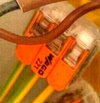WHY do so many installations have metal switches without being earthed to earth wires that are actually present? Very common problem.
You are using an out of date browser. It may not display this or other websites correctly.
You should upgrade or use an alternative browser.
You should upgrade or use an alternative browser.
NEW BUILD SOCKETS HAVE EARTH WiRE BUT light SWITCHES don't (Ed.)
- Thread starter DIYLISA95
- Start date
Sponsored Links
Thanks a bunch
just realised there’s actually four wires into that wago. Can I just take one out for the faceplate and leave the rest?
No, all the earth wires, need to make a metal to metal connection.
If you cannot get four, into the switch earth terminal, then make use of the Wagos.
I'd guess the switches are installed by people who don't know they need earthing and that especially in cases where plastic is swapped for metal someone just swaps them without thinking too hardWHY do so many installations have metal switches without being earthed to earth wires that are actually present? Very common problem.
Another factor may be people picking up information from the USA. In the USA the done thing for lightswitches is not to explicitly earth the switches, but to let them pick up earth from the box. Something we don't generally consider acceptable on this side of the pond (IIRC BS7671 explicitly prohibits it for conduit systems, but is silent about it for accessories fed by cables possibly because they didn't think anyone would do it in the first place).
- Joined
- 27 Jan 2008
- Messages
- 25,359
- Reaction score
- 2,979
- Location
- Llanfair Caereinion, Nr Welshpool
- Country

I spy with my little eye earth wires, same as everyone else
 the problem is of course you really need to test is is an earth, the the gear to test it with is expensive.
the problem is of course you really need to test is is an earth, the the gear to test it with is expensive.  The big question is why fit metal fronts, just leave as it is, can see why you want to fit a dimmer switch or smart switch, but just to have a metal front, why?
The big question is why fit metal fronts, just leave as it is, can see why you want to fit a dimmer switch or smart switch, but just to have a metal front, why?
 the problem is of course you really need to test is is an earth, the the gear to test it with is expensive.
the problem is of course you really need to test is is an earth, the the gear to test it with is expensive.  The big question is why fit metal fronts, just leave as it is, can see why you want to fit a dimmer switch or smart switch, but just to have a metal front, why?
The big question is why fit metal fronts, just leave as it is, can see why you want to fit a dimmer switch or smart switch, but just to have a metal front, why?Sponsored Links
WHY do so many installations have metal switches without being earthed to earth wires that are actually present? Very common problem.
Because DIYers don’t know to fit them, and scum sparks don’t bother. The there are other trades and handy men charging for work they don’t know how to do properly
- Joined
- 25 Apr 2016
- Messages
- 2,642
- Reaction score
- 631
- Country

Why not remove 1 wire from the WAGO and put that into the earth point in the switch along with another piece of (green/yellow) insulated wire that then goes into the recently vacated port. Or have I missed something?
You could run two earth wires to the wago, two the earthy terminal on the switch, and a short link wire between - if you felt the need.
Unless you check out each individual earthwire end to end for continuity which one (or more) is bringing an earth polarity into a position or taking it out to another position, the simplest way is to connect them all together at every position, that usually makes some of them additional to the minimum required which is no bad thing as it often helps bring the R2 value down, it sometimes builds in a little redundancy by making more than one earth path which can save the day in the event of an accidental pullout somewhere else.
As a simple example lets suppose you have two lighting circuits and each one loops along from the origin to the end of the circuit and would measure 1 ohm.
Now lets suppose that about half way along each circuit there is a short piece of earthwire connecting both circuit earths together.
that would make the resistance (impedance) of the R2 for each circuit become approx 0.75 ohms for a start. it would also mean that a break in the first half of either circuit would be about 1 ohm to each end.
Often you have multiple such joints causing parallel paths in the earthwires so might bring the R2 value down even further.
Overall, no bad thing in itself and gives some inbuilt resiliance (actually one link between two parts connecting two different circuits might have an actual figure above zero ohms but even then the basic simple principle of reducing the R2 value overall and alternative paths still remains.
Therefore the simple joining of all earthwires at every position is still the best approach and might actually be an improvement over the minimum values required.
You test the resistance of both circuits independently with bot outgoing earths from the consumer unit disconnected.
you test for a reading end to end on circuit one and end to end on circuit two. All OK.
If you then repeat the tests by joining the earthwires at the start of the circuit together then check the reading at the end of circuit one and then at circuit two then you might notice an improvement.
You could do an experiment using 0.1 ohm resistors to represent the connections between lighting points and similarly from each lighting point to its own switch position.
Actually you could use all 1 ohm or 10 ohm or 100 ohm or even 1K ohm resistors and the basic principle of what you`d find would be apparen even if using a cheap multimeter.
Or you could draw it out on paper and do the calculations.
The joining of earthwires of two radial circuits demonstrates one advantage of a ring circuit in case of a pullout of an earth connection.
As a simple example lets suppose you have two lighting circuits and each one loops along from the origin to the end of the circuit and would measure 1 ohm.
Now lets suppose that about half way along each circuit there is a short piece of earthwire connecting both circuit earths together.
that would make the resistance (impedance) of the R2 for each circuit become approx 0.75 ohms for a start. it would also mean that a break in the first half of either circuit would be about 1 ohm to each end.
Often you have multiple such joints causing parallel paths in the earthwires so might bring the R2 value down even further.
Overall, no bad thing in itself and gives some inbuilt resiliance (actually one link between two parts connecting two different circuits might have an actual figure above zero ohms but even then the basic simple principle of reducing the R2 value overall and alternative paths still remains.
Therefore the simple joining of all earthwires at every position is still the best approach and might actually be an improvement over the minimum values required.
You test the resistance of both circuits independently with bot outgoing earths from the consumer unit disconnected.
you test for a reading end to end on circuit one and end to end on circuit two. All OK.
If you then repeat the tests by joining the earthwires at the start of the circuit together then check the reading at the end of circuit one and then at circuit two then you might notice an improvement.
You could do an experiment using 0.1 ohm resistors to represent the connections between lighting points and similarly from each lighting point to its own switch position.
Actually you could use all 1 ohm or 10 ohm or 100 ohm or even 1K ohm resistors and the basic principle of what you`d find would be apparen even if using a cheap multimeter.
Or you could draw it out on paper and do the calculations.
The joining of earthwires of two radial circuits demonstrates one advantage of a ring circuit in case of a pullout of an earth connection.
DIYnot Local
Staff member
If you need to find a tradesperson to get your job done, please try our local search below, or if you are doing it yourself you can find suppliers local to you.
Select the supplier or trade you require, enter your location to begin your search.
Please select a service and enter a location to continue...
Are you a trade or supplier? You can create your listing free at DIYnot Local
Sponsored Links
Similar threads
- Replies
- 10
- Views
- 4K
